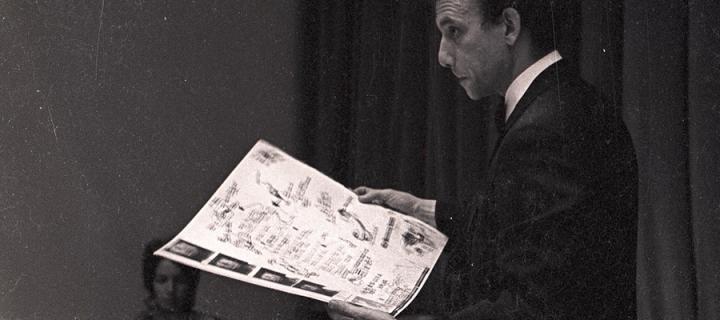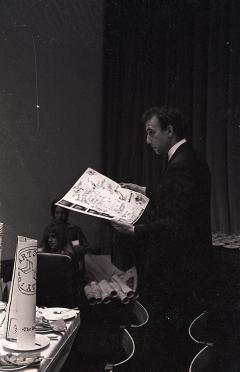4. Daniel Spoerri reading from his menu for The Banana Trap Dinner in C.26 (23 August 1970)
Those lucky enough to experience Daniel Spoerri’s Banana Trap Dinner in the old ECA Boardroom had their senses completely confused by the food on offer.

Daniel Spoerri
Daniel Isaac Feinstein was born in Romania in 1930. His Jewish father, Isaac Feinstein, converted to Christianity after Romania entered the war on the side of the National Socialists, but he was arrested and killed in 1941. His mother emigrated to Switzerland in 1942 and Daniel was adopted by his maternal uncle Professor Theophil Spoerri.
During the 1950s and early 1960s, Spoerri would meet a number of lead figures of Dada and Surrealism, including Marcel Duchamp, as well as those artists who would later become associated with Fluxus, especially Dieter Roth and Robert Filliou. Spoerri, Roth, and Filliou would have work exhibited in the same ECA studio space (E22, First Floor) at Strategy: Get Arts in 1970.
Spoerri was one of the original nine signatories of the manifesto of Nouveau réalisme in April 1960, an artistic movement founded by art critic Pierre Restany, a manifesto which proclaimed ‘new ways of perceiving the real’.
Spoerri’s work demonstrates a strong Dadaist attitude, especially with his ‘Eat Art’ project, which can be traced to the early 1960s, a project that really developed when he opened his own restaurant in June 1968.
Another source of inspiration for ‘Eat Art’ may well have been Filippo Tommaso Marinetti’s Futurist Cookbook (1932), which outlined some very unusual and highly performative recipes.
Menu

Spoerri offered a ‘Gala Dinner’ for invited guests in the ECA boardroom as part of SGA, an experimental meal in line with his ‘Eat Art’ project.
In a letter to Spoerri, dated 8 August 1970 (Richard Demarco Archive, SNGMA), Demarco refers to the experimental Banana Trap Dinner (with a request for two sittings) stating: ‘I have asked John Martin of Forth Studios what it would cost to print seventy “Menus”. He estimates it would probably be approximately £70’.
The menu travesti (‘disguised menus’) were limited edition, signed and dated artworks by Spoerri.
The artist intended a mismatch between the senses of sight and taste, with dishes such as mashed potato resembling ice cream and garnished with a salty biscuit, or a marzipan sausage for dessert. The dinner was served by candlelight to further confound the senses.
The menus can be seen in various photographs by George Oliver. Spoerri would go on to open his ‘Eat-Art-Gallery’ in the upstairs of Restaurant Spoerri in Düsseldorf on 18 September 1970, not long after the dinner at ECA.
In addition to cooking the infamous Banana Trap Dinner at SGA, Spoerri also exhibited a series of fetish-like objects in glass cases, objects known as Magie à la noix (1967) that had been created on the Greek island of Symi. Today the whole series is located at the Museum Schloss Morsbroich in Leverkusen (Germany).
C.W.


